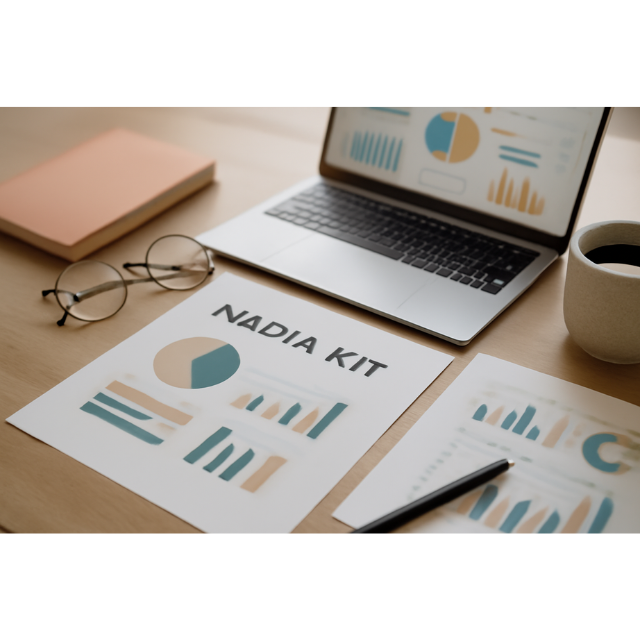How to Create a Media Kit that Attracts Opportunities
Creating a media kit might sound intimidating, but it’s one of the most powerful tools you can have to showcase your brand, attract collaborations, and land sponsorships. Whether you’re a designer, content creator, freelancer, or small business owner, a well-crafted media kit can open doors to new opportunities.
In this guide, I’ll walk you through the essentials of building a visually professional media kit that not only looks great but also clearly communicates your value.
What Is a Media Kit?
A media kit is a document or digital file that presents key information about your brand, services, audience, and achievements. It’s usually used when pitching to potential partners, sponsors, or clients.
Think of it as your brand’s resume — concise, compelling, and visually appealing.
Why Do You Need One?
- Professionalism: Shows that you’re serious and organized
- Efficiency: Saves time by compiling all important info in one place
- Marketing Tool: Highlights your strengths and what sets you apart
- Facilitates Partnerships: Makes it easier for others to say “yes” to working with you
Key Elements of a Professional Media Kit
1. Introduction
Start with a quick overview of who you are and what you do:
- Name and Title
- Brand Statement
- Mission Statement
Example:
Hi, I’m Jane Doe, a freelance graphic designer specializing in brand identity and web design. My mission is to help small businesses create compelling visual narratives that resonate with their audience.
2. Contact Information
Make it easy for people to reach you:
- Email address
- Phone number
- Website URL
- Social media handles
✅ Keep this section up to date and easy to find.
3. Services Offered
List what you offer clearly and confidently:
- Graphic Design
- Web Development
- Content Creation
- Social Media Management
📦 You can also include service packages or pricing if relevant.
4. Audience Demographics
If you already have an audience, share some insights:
- Age range
- Gender distribution
- Geographic location
- Interests
📊 Use charts or infographics to make this visual and engaging.
5. Social Media Statistics
Showcase your reach and engagement:
- Followers/subscribers
- Engagement rate (likes, comments, shares)
- Website traffic (monthly visitors, page views)
📈 Use graphs or icons to make data easier to digest.
6. Testimonials and Case Studies
Let others vouch for you!
Example:
“Jane transformed our brand identity, and our customer engagement has doubled since.”
— John Smith, CEO of XYZ Corp.
Or include mini case studies with clear results.
7. Previous Collaborations
If you’ve worked with notable brands or clients, list them.
Use logos (with permission) for stronger impact.
8. Portfolio Samples
Show off your best work with:
- Project title
- Client name
- Short description and outcome
- High-quality images
🖼️ This helps potential collaborators trust your capabilities.
9. Press Features
Have you been featured in blogs, podcasts, or the media?
Include quotes or links — it builds trust and authority.
10. Call to Action
Wrap it up with a friendly but direct invitation:
Example:
Ready to collaborate? Let’s create something amazing together.
Reach out at [your email].
Design Tips for a Visually Appealing Media Kit
- Consistency: Use your brand colors, fonts, and tone
- Simplicity: Don’t overload the page — white space is your friend
- High-quality visuals: Keep everything crisp and professional
- Readable fonts: Choose ones that are easy to read
- Interactive elements: Add clickable links in digital versions
Tools to Create Your Media Kit
You don’t need to be a designer! Try:
- Canva – Drag-and-drop, beginner-friendly
- Adobe InDesign – Pro-level flexibility
- Google Slides – Easy and accessible
- PowerPoint – Familiar interface with design potential
How to Share Your Media Kit
- PDF Format – Great for email and downloads
- On Your Website – Create a dedicated “Media Kit” page
- Cloud Links – Use Google Drive or Dropbox
- Printed Copies – For in-person networking or events
💡 Just make sure it’s easy to access!
Keep Your Media Kit Updated
Review your media kit every quarter or after big milestones. Update:
- Services or pricing
- Audience or traffic stats
- Portfolio samples
- Testimonials or press mentions
Before I Had a Media Kit…
Honestly, when I first heard about media kits, I thought they were just for big influencers or agencies. I didn’t think my blog or business was “big enough” to need one.
But I was wrong.
When I finally created my first media kit, it felt like I had just leveled up professionally. Suddenly, I had brands replying to my emails, collaborators taking me more seriously, and new doors opening that I hadn’t even considered.
It wasn’t magic — it was clarity. ✨
Pro Tips for Making It Shine
- Tailor your media kit for different audiences when necessary
- Don’t be afraid to inject a bit of personality — it’s your brand!
- Use real examples and numbers whenever possible
FAQ
Q: Do I need a media kit even if I’m just starting out?
A: Yes! Even a simple one shows that you take your work seriously.
Q: What if my stats aren’t impressive yet?
A: Focus on your value, strengths, and future goals.
Q: Should I hire someone to design it?
A: Only if you want to. With tools like Canva, you can do a great job on your own!
Final Thought from Me to You
Creating a media kit isn’t just about looking professional — it’s about knowing your value and being ready to present it to the world. Whether you’re just starting out or growing fast, a media kit gives your brand a voice and structure.
If I can do it, you absolutely can too.
So go ahead — start crafting yours today.
I promise you: the opportunities will follow.
From zero to design hero — keep creating!
by Cris.

